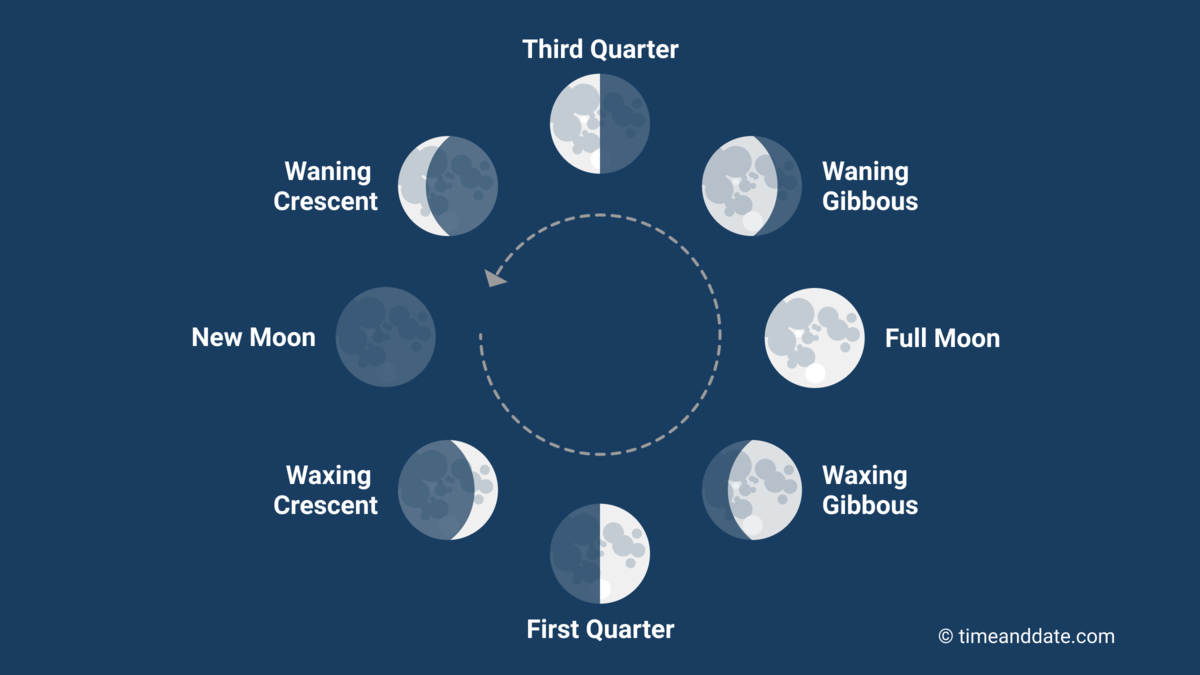All About the Moon Cycle
In ancient indigenous cultures, the Moon has always held a special place and was worshipped for its rhythms of life and the universe. Just as we move through different phases in life, so does the Moon; no matter if the Moon can be seen or not, it’s always with us. In this blog, we will explore the Moon cycle in nature and astrology, along with its connection to femininity and how it’s celebrated uniquely around the world.
Understanding the Moon Cycle

Pictured: Moon Cycles Source: Time and Date
Every 29.5 days, the Moon goes through eight phases. A Moon cycle can be described as changes in appearance created by shifting angles or positions of the Moon, in relation to the Earth and the Sun. Here are the eight Moon phases and their significance in nature:
New Moon
Moon Phase: Primary
Moonrise: Around Sunrise | Moonset: Around Sunset
Illumination: 0%
Position in Space: During this phase, the Moon is between the Sun and Earth. If the Moon’s path crosses the plane of Earth’s orbit around the Sun while the Sun, Moon, and Earth are aligned at New Moon, a solar eclipse happens somewhere in the world.
Waxing Crescent Moon
Moon Phase: Intermediate
Moonrise: Morning | Moonset: Afternoon
Illumination: 0.1% to 49.9%
Orientation: The right half of the Moon is lit in the Northern Hemisphere, while the left half is lit in the Southern Hemisphere.
Position in Space: During this phase, the Moon is transitioning from New Moon to First Quarter Moon. The Crescent phases can be an excellent time to see Earthshine, which is when sunlight reflected from Earth gives the dark areas of the Moon a faint glow.
First Quarter Moon (Half Moon)
Moon phase: Primary
Moonrise: Around Midday | Moonset: Around Midnight
Illumination: 50%
Orientation: The right half of the Moon is lit in the Northern Hemisphere, while the left half is lit in the Southern Hemisphere.
Position in Space: During this phase, the Moon has gone one-quarter of the way around Earth.
You can look for the First Quarter Moon in the blue afternoon sky.
Waxing Gibbous Moon
Moon Phase: Intermediate
Moonrise: Afternoon | Moonset: Early Morning
Illumination: 50.1% to 99.9%
Orientation: The right half of the Moon is lit in the Northern Hemisphere, while the left half is lit in the Southern Hemisphere.
Position in Space: During this phase, the Moon is moving from First Quarter to Full Moon. A couple of days into the Waxing Gibbous Moon phase, you can see the Golden Handle, which is a lunar light phenomenon that occurs when sunlight hits the Montes Jura Mountain Range at a low angle, causing the mountain range to glow in stunning detail.
Full Moon
Moon Phase: Primary
Moonrise: Around Sunset | Moonset: Around Sunrise
Illumination: 100%
Position in Space: During this phase, the Moon and the Sun are on opposite sides of the Earth. If the Moon’s path crosses the plane of Earth’s orbit around the Sun while the Sun, Earth, and Moon are aligned, a lunar eclipse can be observed on the side of Earth experiencing nighttime.
Waning Gibbous Moon
Moon phase: Intermediate
Moonrise: Evening | Moonset: Morning
Illumination: 99.9% to 49.9%
Orientation: The left half of the moon is lit in the Northern Hemisphere, while the right half is lit in the Southern Hemisphere.
Position in Space: During this phase, the Moon is moving from Full Moon to Third Quarter Moon, but it can still look nearly full for a few days after Full Moon.
Third Quarter Moon (Half Moon)
Moon phase: Primary
Moonrise: Around Midnight | Moonset: Around Midday
Illumination: 50%
Orientation: The left half of the moon is lit in the Northern Hemisphere, while the right half is lit in the Southern Hemisphere.
Position in Space: During this phase, the Moon has gone three-quarters of the way through its orbit around Earth. The Third Quarter Moon begins on the last quarter of the lunar cycle.
Waning Crescent Moon
Moon phase: Intermediate
Moonrise: Early Morning | Moonset: Afternoon
Illumination: 49.9% to 0.1%
Orientation: The left half of the moon is lit in the Northern Hemisphere, while the right half is lit in the Southern Hemisphere.
Position in space: During this phase, the Moon is moving from Third Quarter to New Moon.
The Moon Cycle and Astrology
Just like the Sun’s placement in the sky can help predict your personality traits and even influence current events, the phase the moon is in at any given time — and the cycle you were born under — has a huge influence on your life, mindset, and mood.
To find out what the Moon looked like when you were born, plug your birth date, time, and location into a birth chart generator, such as this one.
Here’s a deeper look into the influence the Moon cycle can have on you:
New Moon
The New Moon is a time of reflection. During New Moons, you can lean into the Moon’s energy by reassessing your options or reviewing your plans for the next few days, weeks, or even months.
Those born under a New Moon are adventurous, enthusiastic, and creative. They enjoy trying new things and facing new challenges in life. However, they are less likely to find a life partner than someone born on a Full Moon. They may be on the more thoughtful end of the spectrum regarding love, holding out for a perfect match.
Waxing Crescent Moon
During a Waxing Crescent, it’s important to make moves towards your goals and desired outcomes for the month. This is the time to start planting the seeds for your future by taking the first steps toward your goals.
Those born under a Crescent Moon are often self-assertive and determined with a desire to follow what may seem like an inner command or personal urge. These individuals are drawn to do good in the world; however, they can sometimes feel a sense of struggle and frustration in life.
First Quarter Moon
The First Quarter Moon is a time to take action. Try to be brave as you set forth the goals you are planning and reaching for. You may notice you tend to make more decisions during the first Quarter Moons.
Those born under the First Quarter Moon phase have a strong will and an ability to push through obstacles and make decisions. They often experience personal satisfaction in overcoming obstacles, but there can be a tendency toward escapism and a defeatist attitude engrained in their negative side.
Waxing Gibbous Moon
The Waxing Gibbous Moon is a time to take stock of where you’re at with your plans and goals and assess your strategy for moving forward. You can look at this phase as the time to refine ideas.
Those born under a Gibbous Moon are often eager to improve others and themselves and have an innate ability to evaluate things carefully, leading to the ability to bring things to a successful conclusion. They tend to have strong connections too, surrounding themselves with loved ones, friends, and family.
Full Moon
The Full Moon is when the Moon is the most energetic. During this time, your strength may be intense and your confidence high, so it’s the time for action. Those born under a Full Moon often have concrete ideas, but they may find themselves shifting quickly from emotional to logical thinking.
The Full Moon is a time for guidance and healing. An evening before this phase can be perfect for recharging your energy. Sit outside and bask in the moonlight. Also, crystals, oracle cards, and meaningful jewelry can be exposed to the Moon to cleanse and charge up with lunar energy.
Waning Gibbous Moon
The Waning Gibbous is also known as the Dissemination Moon, which brings about energy for better communication, revelation, and completion. This is a time to reflect on your actions from this past month, and also a great time to figure out ways to enhance your life’s journey.
Those born under a Waning Gibbous Moon may have an innate ability to demonstrate what they’ve learned, and they fight for what they believe in. On the negative end, there can be tendencies toward fanaticism or mental confusion.
Third Quarter Moon
The Third Quarter Moon can make it easier to let go of what’s not working for you. Each path is unique as we are all special in our talents and goals, but this is where you can be true to yourself as you make life yours.
Those born under the Third Quarter Moon often have organizational and managerial abilities. They have broad social ideals and can force issues and create a crisis to transform something, as well as build new systems and work for future goals regardless of personal cost.
Waning Crescent Moon
A Waning Crescent Moon is a perfect opportunity for downtime. This is the time for you to zone out and rest up as you have built a stable path. Before you step forward again, you’ll need to recharge your batteries.
Those born under a Waning Crescent Moon may experience eagerness to serve in organized groups and social institutions. They can often feel a sense of personal destiny or as if they’re being led by superior powers; they may even have a prophetic gift.
The Moon and Feminine Energy
There are so many representations of the Moon throughout various cultures. Most often, the Moon is represented as feminine energy, while the Sun is associated with masculine energy. This does not mean working with the moon is only for women as we each have both masculine and feminine energies in our makeup.
In the case of the Moon, feminine energy is associated with yin energy: being, feeling, receiving, surrender, ease, and flow. Feminine represents the softer, cooler, darker energies that allow us to flow with cycles, receive, and surrender.
Masculine energy is associated with yang energy: doing, thinking, action, effort, and forward motion. Masculine represents the harder, hotter, and firey energies that allow us to push forward, persevere, actively create, and make things happen.
The entire universe needs a balance of masculine and feminine energies to thrive in harmony, as do each of us. However, we live in a masculine society that, for thousands of years, has valued masculine energies over the feminine.
We believe the way to success is in hard work, pushing, fighting, the struggle, and overcoming obstacles. Excessive masculine energy may be the cause of increased violence, aggression, and exploitation of the planet. In our day-to-day lives, excessive masculine energy can cause burnout, anxiety, stress, and their resulting health problems.
Working with the Moon is one way to restore the energetic balance. Whether you are male, female, or nonbinary, working in harmony with the cycles of nature can help to bring a greater connection to the divine feminine and allow your life to naturally flow the way it should – with ease.
The Moon as the Triple Goddess
This Triple Goddess is symbolized by the Waxing, Full, and Waning Moons, which represent the three phases of the goddess – Maiden, Mother, and Crone. There have been countless representations of these three women in the arts around the world. Here is a look at the Triple Goddess in relation to the Moon:
The Maiden represents the Waxing Moon, growing larger in the sky. The Maiden symbolizes the early phases of life that are full of potential. Think new beginnings, expansion, youth, and excitement.
The Mother represents the Full Moon. Mother energy is full of creativity and nurturing; representing the midpoint in life. She is fertility, power, stability, and fulfillment. Whether you are caring for a child or loved one, or tending to a project or business, you are in your Mother energy.
The Crone represents the Waning Moon, growing smaller in the sky. The Crone symbolizes the last phase of life; one where we have gathered wisdom from living through the previous cycles and we can surrender knowing that we’ve done all we can. She is the elder, the teacher, the keeper of wisdom, and the holder of compassion.
Each month you have the opportunity to harness the excitement and potential of the Maiden, the power and fulfillment of the Mother, and the wisdom and intuition of the Crone. Learning to live in accordance with these Waxing and Waning energies can change how you see the world and your own life.
You can learn more about feminine archetypes here.
How To Begin Working With the Moon
While it may seem that there is a lot to learn, working with the energy of the Moon does not have to be an overwhelming task. You can follow these simple steps to begin your lunar journey:
- Get a Moon cycle app, planner, or calendar. This will also help you see when the major shifts in the Moon phases are going to occur. Often standard calendars will include the New Moon, First Quarter Moon, Full Moon, and Third Quarter Moon.
- Start small. Begin by becoming aware of the Moon. When you’re outside, look up. Notice when the Moon is Waxing, Full, Waning, or New. You’ll start to realize the rhythm and cycle and this will help you as you start to work with these phases.
- Create your own routines, rituals, ceremonies, or habits that you do around the time of the New Moon and the Full Moon. These recommendations from Yasmin Boland are wonderful ways to begin your Moon rituals.
- Find events near you. Check your local yoga studio to see if they have any Moon-related yoga classes or meditations. You can also scour the internet for women’s groups and Moon circles in your area. If there aren’t any events near you, you can join online communities that offer membership Moon planning, meditations, and rituals. The Human Beauty Movement (The HBM), for example, often hosts events surrounding the Moon cycle. Click here to join The HBM community and learn more about the upcoming lunar events.
Moon Cycle Rituals Around the World
The Moon has been celebrated by different cultures for various reasons throughout history. The following rituals of ancient and modern cultures around the globe can provide you with inspiration for your own Moon ceremony:
Native American Moon Dance

Pictured: Native American’s performing the Moon Dance Source: Pow Wows
The Moon Dance is an ancient indigenous practice of Native Americans that comes in addition to the Sun Dance. Both dances involve the gathering of a community and focus on praying and dancing for the sake of healing. The Moon Dance also worships the feminine energy and Mother Earth.
The dance aims at reuniting women, men, and children with the Earth and the essence of the Moon. It’s a three-day ceremonial dance taking place on the Full Moon. During the night, the community gathers together to dance, sing, and share sacred teachings under the Moon, while the days are for resting and recharging.
Hindu Full Moon Ritual

Pictured: Hindu Woman Fasting During the Full Moon Festival Source: La Croix International
Hindus believe that the Moon in its fullest state has a great influence on human anatomy, just as it affects the bodies of water on Earth. During a Full Moon, people might become restless, irritable, and even ‘lunatic‘, a term derived from the Latin word for Moon “luna.”
In Hinduism, the Full Moon day is called “Purnima.” It’s a very felicitous day in the Hindu calendar promising prosperity, and happiness. Therefore, it’s celebrated with a strict fast from sunrise to sunset and praying to the presiding deity, Lord Vishnu. After the whole day of fasting, praying, and reflecting, they take a dip in the river and consume some light food at dusk.
Lunar New Year in China

Pictured: Lunar New Year in China Celebration Source: BBC
Known as Lunar New Year, or Chinese New Year, this festival is typically celebrated in China and other Asian countries. The celebration begins with the first New Moon of the lunar calendar and ends 15 days later on the first Full Moon of the lunar calendar.
Lunar New Year celebrations are known to usher out the old year and bring forth the luck and prosperity of the new one. Festivities often include firecrackers, fireworks, and red clothes and decorations. In addition, Lunar New Year is a time to feast and visit family members.
In Conclusion
Celebrating the Moon cycle can be very powerful for your self-development. The Full Moon, for example, always marks a time of change and re-birth; it’s a perfect time to let go of the things that are holding you back from living your best life and reaching your fullest potential.
How do you celebrate the Moon cycle? Let us know in the comments!











